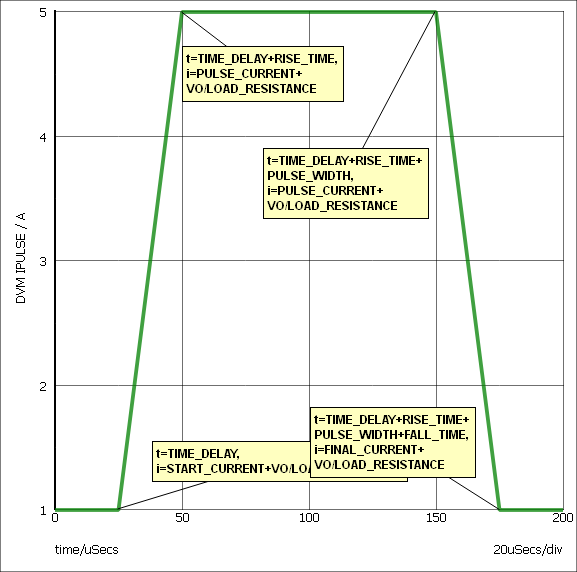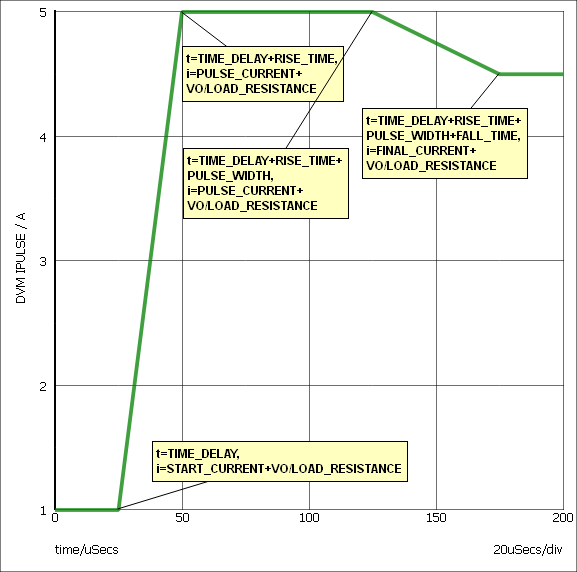Pulse Load - Single Current Pulse
The Pulse Load - Single Current Pulse subcircuit models a single pulse in parallel with a resistive load. At time=0, the load starts at the resistive load. The load pulse is determined by the pulse parameters. You can configure any managed DVM load to a Ramp Pure Load with a Pulse() function call in the Load column of your testplan.
In DVM, this load is used in the following test objectives:
Other similar loads include the following:
- Ramp Load - a ramped load where the starting current is modeled with a resistor and the ramp current is modeled with a PWL current source
- Ramp Pure Load - a ramped load where both the starting current and the ramp current are modeled with a current source
- Pulse Load - Single Pure Current Pulse - a single current pulse modeled with a current source
- Pulse Load - Repeating Pure Current Pulse - a repeating current pulse load
In this topic:
| DVM Information | Power Supply (Non-DVM) Information | |||||||
| Model Name | Pulse Load - Single Current Pulse | |||||||
| Simulator |
 This device is compatible with both the SIMetrix and SIMPLIS
simulators. This device is compatible with both the SIMetrix and SIMPLIS
simulators. |
|||||||
| Parts
Selector Menu Location |
|
|||||||
| Symbol Library | SIMPLIS_DVM_ADVANCED.sxslb | power_supply_source_and_loads.sxslb | ||||||
| Model File | SIMPLIS_DVM_ADVANCED.lb | power_supply_source_and_loads.lb | ||||||
| Subcircuit Name |
|
POWER_SUPPLY_LOAD_PULSE | ||||||
| Symbols |
|
|
||||||
| Schematic - 2 Terminal |

Note: Power Supply probes will not have the "DVM" prefix.
|
|||||||
| Schematic - 3 Terminal |
 Note: Power Supply probes will not have the "DVM" prefix.
|
|||||||
| Schematic - 4 Terminal |
 Note: Power Supply probes will not have the "DVM"
prefix.
|
|||||||
Parameters
The table below explains the parameters used in the Pulse Load - Single Current Pulse subcircuit.
| Parameter Name | Default | Data Type | Range | Units | Parameter Description |
| FALL_TIME | 50u | Real | min: 0 | s | The pulse fall time in seconds |
| FINAL_CURRENT | 750m | Real | min: 0 | A | The final current for the PWL current source portion of the load. The Pulse Load - Single Current Pulse continues at this current for all simulation times greater than TIME_DELAY + RISE_TIME. This can be a numeric value or a symbolic value, such as a percentage of full load. |
| LOAD_NAME | LOAD | String | n/a | n/a | Name of the DVM load. This name cannot contain spaces. |
| LOAD_RESISTANCE | 2.00667 | Real | min: 0 | Ω | The resistance value which models the starting current of the load |
| PULSE_CURRENT | 250m | Real | min: 0 | A | The pulsed current in amps. The pulse current can be a numeric value or a symbolic value, such as a percentage of full load. |
| PULSE_WIDTH | 200u | Real | min: 0 | s | The pulse width in seconds.
DVM considers the pulse width to be the duration of the pulse at the PULSE_CURRENT. |
| RISE_TIME | 100u | Real | min: 0 | s | The pulse rise time in seconds |
| START_CURRENT | 0 | Real | min: 0 | A | The starting current for the PWL current source portion of the load. This is typically set to 0 since the minimum load current is modeled with the LOAD_RESISTANCE parameter. |
| TIME_DELAY | 10u | Real | min: 0 | s | The time delay before the pulse initiates |
DVM Testplan Entry
To set any managed DVM load to a Pulse Load - Single Current Pulse subcircuit, place a Pulse() testplan entry in the Load column.
The Pulse() testplan entry has the following syntax with the arguments explained in the table below.
Pulse(REF, ISTART, IPULSE, IFINAL) Pulse(REF, ISTART, IPULSE, IFINAL, OPTIONAL_PARAMETER_STRING)
where:
| Argument | Range | Description |
| REF | n/a | The actual reference designator of the DVM load or the more generic syntax of OUTPUT:n where n is an integer indicating a position in the list of DVM loads. |
| ISTART | min: 0 | The starting current for the load. In the Pulse load, the starting current is modeled with a resistor. This can be a numeric value or a symbolic value, such as a percentage of full load. |
| IFINAL | min: 0 | The final current for the load. This can be a numeric value or a symbolic value, such as a percentage of full load. |
| OPTIONAL_PARAMETER_STRING | n/a |
Parameter string with a combination of one or more timing parameters:
|
* If more than one parameter is specified, join the parameter key-value pairs with a space, as shown in the example below. The order of the parameter names does not matter.
DVM calculates the LOAD_RESISTANCE parameter from the ???MATH???I_{START}???MATH??? argument and subtracts the equivalent starting current from the PWL portion of the load. The calculation for the LOAD_RESISTANCE parameter is based on the following:
- The nominal output voltage which is entered in the Output page of the Full Power Assist Control Symbol.
- The starting load current given in the Pulse() function or the PulseLoad() objective.
Timing
DVM sets the timing of the Pulse Load - Single Current Pulse in the PulseLoad() test objective. You can change the timing with a Pulse() function call by providing the timing parameters as an optional parameter string, which is the fifth argument to the Pulse() function call.
Symmetric Pulse DVM Example
This example shows a symmetric pulse with equal rise and fall times. The final current is the same as the starting current.
| *?@ Load |
|---|
| Pulse(OUTPUT:1, 1, 5, 1, TIME_DELAY=25u RISE_TIME=25u PULSE_WIDTH=100u FALL_TIME=25u) |
The results of this testplan entry are shown below:

| Annotation | Value |
| X0 | TIME_DELAY |
| X1 | TIME_DELAY + RISE_TIME |
| X2 | TIME_DELAY + RISE_TIME + PULSE_WIDTH |
| X3 | TIME_DELAY + RISE_TIME + PULSE_WIDTH + FALL_TIME |
| Y0 | ISTART (see note below) |
| Y1 | IPULSE (see note below) |
| Y2 | IPULSE (see note below) |
| Y3 | IFINAL (see note below) |
Asymmetric Pulse DVM Example
The following example sets the first DVM managed load to a Pulse Load - Single Current Pulse with a starting current of 1A, a pulse current of 5A, and a final current of 4.5A.
| *?@ Load |
|---|
| Pulse(OUTPUT:1, 1, 5, 4.5, TIME_DELAY=25u RISE_TIME=25u PULSE_WIDTH=75u FALL_TIME=50u) |
The results of this testplan entry are shown below:

| Annotation | Value |
| X0 | TIME_DELAY |
| X1 | TIME_DELAY + RISE_TIME |
| X2 | TIME_DELAY + RISE_TIME + PULSE_WIDTH |
| X3 | TIME_DELAY + RISE_TIME + PULSE_WIDTH + FALL_TIME |
| Y0 | ISTART (see note below) |
| Y1 | IPULSE (see note below) |
| Y2 | IPULSE (see note below) |
| Y3 | IFINAL (see note below) |
Converting between DVM and Power Supply Loads
To change a Power Supply load to a DVM load, right click the symbol to bring up the context menu, and select the menu option: Upgrade to DVM Source/Load
To change a DVM load to a Power Supply load, right click the symbol to bring up the context menu, and select the menu option: Downgrade to SIMetrix/SIMPLIS Source/Load





